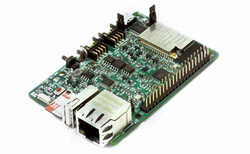Open Hardware: Mini Computers, Modding Devices in Europe, Arduino, and More
-
EsPiFF board combines ESP32 module with RP2040 MCU in the Raspberry Pi 4 form factor (Crowdfunding) - CNX Software
The EsPiFF board may look like a Raspberry Pi 4 Linux SBC but it is equipped with an ESP32-WROVER WiFi and Bluetooth module together with a Raspberry Pi RP2040 microcontroller that acts as a co-processor.
The goal here is to provide a Raspberry Pi 4 replacement for applications that require higher reliability and even 24/7 operation without necessarily needing the processing power and multimedia capabilities of the Broadcom BCM2711 Arm processor found in the Pi or the versatility of a Linux operating system.
-
Sign the open letter about the universal right to install any software on any device - The Document Foundation Blog
The ongoing digitization of infrastructures and services comes along with a continuously growing number of electronic devices that are connected to the Internet – be it in private, public or business environments. Many of these devices need more energy and natural resources to be produced than the energy they consume during their entire lifespan. And way too many of these devices are being wasted and not reparable simply because the software stops working or is not being updated anymore.
Once the pre-installed software stops users from continuing to use their hardware, restrictive ownership models prevent users from helping themselves to enjoy longer use of their devices. Restrictions span from physically locking down hardware, to technical obscurity by using proprietary software, to legal restrictions via software licenses and end user license agreements. This way, manufacturers often prohibit repairability, access and reuse of their devices. Even after purchase, customers often do not really own their devices. They are not able to do what they want with their very own devices. If you cannot install the software you want on your own device – you don’t own it.
We, the signees of this open letter,
-
Sign our open letter about the right to install any software on any device
More than 100 civil society organisations across sectors have already signed our open letter about “The universal right to install any software on any device”. Now, in the European Week for Waste Reduction, we open up the letter to be signed by individuals. Join our cause and make your voice heard!
The European Union is about to redefine its ecodesign criteria for products within several legislative proposals in the upcoming months. The European Commission has already published a proposal for the “Sustainable Products Initiative” as well as the “Directive on empowering consumers for the green transition”. Now it is time for the European Parliament and Council to start its reading and come to a conclusion. We have written an open letter to help them do things right and use the European Week for Waste Reduction (EWWR) to make our voice heard!
-
Build your own coffee roaster out of a hot air popcorn popper | Arduino Blog
Green (unroasted) coffee beans cost about half as much as their roasted counterparts. By purchasing green coffee beans, you can save quite a bit of money in the long term. Roasting your own coffee beans also gives you much greater control over the flavor profile and caffeine content of your coffee (caffeine content is a debatable topic, but light roasts seem to have more caffeine due to overall density). But buying a coffee roasting machine can drain your savings, which is why you might want to follow Eric Sorensen’s lead and build your own coffee roaster.
Roasting coffee beans is not a complex process. In theory, you could roast your wake-up beans in any old oven. But dedicated machines can roast the beans with more consistency to avoid burned or under-roasted individuals. Those machines are very similar to the air poppers used for popping popcorn. They contain a heating element and a motor that spins a fan and agitates the beans. But coffee bean roasting machines add precision temperature control, which increases their price dramatically. By adding your own temperature control to a cheap air popper, you can save a lot of money and still get great results.
-
Allwinner T3 automotive-grade processor powers industrial-grade SoM - CNX Software
Allwinner T3 is a quad-core Cortex-A7 automotive-grade processor that supports a wide industrial temperature range of -40°C to +85°C. After comparing the specifications of Allwinner T3, I think it is the same as Allwinner A40i, as Allwinner has different business units and the T-series is for the automotive-grade market, while the A-series has historically been for the tablet market, but is now also used in the industrial-grade market.
Tronlong SOM-TLT3 and SOM-TLT3-B are Allwinner T3 system-on-modules (SoM) of Allwinner T3. Both modules have basically the same specifications but the SOM-TLT3 comes with castellated holes for soldering to the carrier board, while the SOM-TLT3-B features board-to-board connectors.

